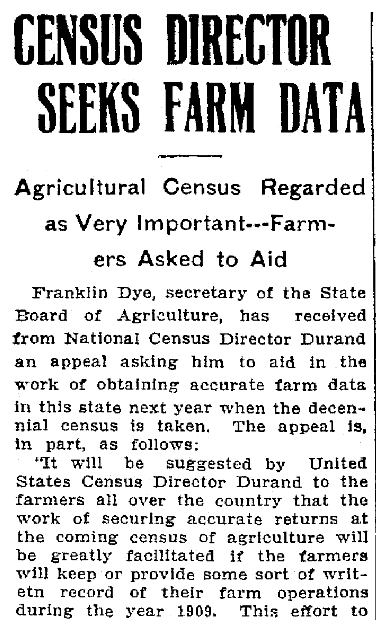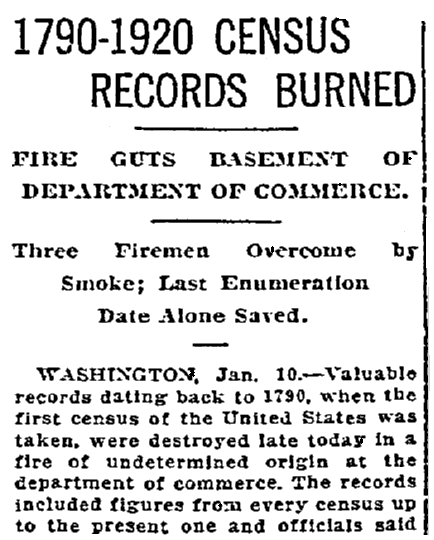Introduction: In this article – part of an ongoing “Introduction to Genealogy” series – Gena Philibert-Ortega provides search tips to help you find your ancestor in the U.S. census records. Gena is a genealogist and author of the book “From the Family Kitchen.”
Each census record tells us something important about our ancestors. Clues to their birth place or occupation, a home address, or the names of extended family members living with or near bring us a step closer to better understanding their lives. It is important to study each census documenting our ancestors and determine what it is telling us and what records we should explore next.
While information collected by the census evolves over time, there are some tips that can help you search any census year. Can’t find your ancestor on the census? Try the following.
Mind the Name
What is in a name? Well if it’s on a census it can be misspelled, not written out completely, or the surname can be partially written as a middle name (for example, when the surname starts with Van or Mac). Simply put, there’s a lot of room for error when we are talking about the U.S. census. Add to these issues the problem of transcription errors or incorrect indexing, and it is probably a wonder that we are able to find our ancestors at all!
So how do you best approach problems with names? Keep a names list. On that list, write out all the variations and creative misspellings for your ancestor’s surname. This is important because you never know how a name may have been written by the census enumerator. In addition, think about your ancestor’s first name, and jot down all those possible variations. Don’t forget that your ancestor might be listed by initials, so write those down as well.
Some subscription websites offer additional tools like wild card searches and even the ability to use the Soundex – which indexes a name by the way it sounds and not how it is spelled. Consider trying multiple searches using each available tool.
One last reminder: not every census year includes everyone’s name. Remember that the 1790 census and all censuses taken up until 1840 only enumerated the heads of household.
Some of the Census Information Might Not Be Correct
The name of the informant for the census information is not revealed until the 1940 U.S. Census. Since we can’t know who gave the information in the earlier censuses, we should be careful about assuming everything documented about our ancestor is correct. Someone not related or not knowledgeable about the individual may have provided the census information. Or you may even have a situation where a family member gave misleading information because of a distrust or fear of the government. Was English your ancestor’s first language? That can also mean misspellings or misunderstandings in answering questions.

Search beyond the Population Schedule
As family historians, we spend the majority of our census research time using population schedules. There’s a good reason for this: they document the greatest number of people. But they aren’t the only census schedule – so don’t stop there.
Other schedules exist including the Indian, mortality, agriculture, slave, and manufacturing. Even state and territorial censuses should be checked (but please note that not every state conducted a state or territorial census). Not sure what census schedules exist for a particular year? Learn more about this on the FamilySearch Family History Research Wiki’s page United States Census.
Don’t Cry over the Lost 1890 U.S. Census
One of the first tragedies you learn about when you begin your family history pursuit is the 1921 fire that destroyed most of the 1890 U.S. Census.

Sure, an intact 1890 U.S. Census would make life easier – but the lack of a census for that time period doesn’t have to be the ultimate brick wall. What should you do when a record doesn’t exist? Consider alternatives that provide similar information. Censuses provide a way to determine where our ancestor was at a specific place and time. What other records provide that information? A few alternatives to consider include a state census, city directories, tax lists, and newspapers.
What’s available for your ancestor’s city during the 1890s? Conduct a Place search in the FamilySearch Catalog, and check library and archive catalogs to find additional resources.
Not all of the 1890 U.S. Census was destroyed. Refer to the United States Census 1890 page on the FamilySearch Wiki for a list of what portions survived.
Try the Old-Fashioned Way
It wasn’t too terribly long ago that family historians spent their time going to a Family History Center or library, grabbing the appropriate microfilm, and advancing the microfilm frame by frame as they read each name hoping to find their family. Today, you may decide to use a variation of this method using your favorite subscription or free website. Go to the census database you are interested in and search page-by-page, using the browse feature, to find the city you are interested in – and then browse through each frame carefully studying the names.
Having a problem finding someone in the census? Take a deep breath and go through each of the above tips and see if that helps. I also find that asking someone else to search might be of use. When we are frustrated and tired, having fresh eyes on the problem can make a real difference.
Good luck!
Related Article:

I’m especially interested in BUBEL (Michigan) genealogies.
Hi Ellis,
Have you tried Google Books, Internet Archive, or FamilySearch? Each of these resources have digitized books that may be helpful. In the FamilySearch Catalog use the Surname search for possible books or other records.
Also, make sure to conduct a search on GenealogyBank for BUBEL and Michigan to see what results may exist. Once you conduct that search, you should conduct another search with just BUBEL and no place or date range.
Good luck!
Gena